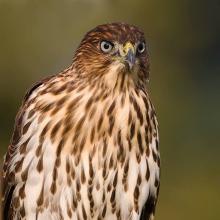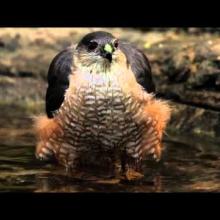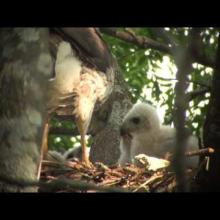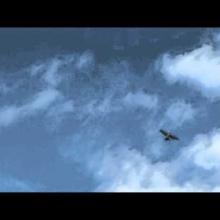

Join BirdNote tomorrow, November 30th!
Illustrator David Sibley and actor H. Jon Benjamin will face off in the bird illustration battle of the century during BirdNote's Year-end Celebration and Auction!
One morning in April, Al Parker of the Mount Auburn Cemetery staff was fishing with his brother at Horn Pond in Woburn, Massachusetts, near the Arlington Road entrance. He heard a branch snapping on a nearby tree and he looked up at that recognizable sound and saw a Cooper's Hawk take off. The hawk flew to a tree not far from him and disappeared for a couple of minutes. Then it flew out and landed on another nearby tree and began prying another branch. Further down the path, he saw another Cooper's Hawk land on a tree and begin working on a branch. Each of the hawks pried branches from the trees and flew back to the same tree to deposit them.
The sound of a hawk snapping the branch off of a tree is unmistakable. Al knew that sound. He walked over to the tree where both hawks had landed and scanned it until he saw the mass of a nest somewhat hidden by foliage but nevertheless visible. Al, a keen birder and observer, had discovered a Cooper's Hawk nest. This was a prize. Through the years we have watched many Red-tailed Hawk nests, but a Cooper's Hawk nest was a first. Photographer Andy Provost has been photographing wildlife for more than thirty years and this was his first Coop nest. We had all seen and photographed the occasional Coop through the years, many times at Mount Auburn Cemetery and at the Mystic Lakes and other areas, but to have access to a nest was a bonanza for us.
I was at Mount Auburn Cemetery when Al told me about the nest, and the next morning I was at Horn Pond bright and early. Al and his brother were there fishing again so he was able to show me the nest.
I looked up and sitting at the edge of the nest was, I assumed, the female Coop. She was looking right down at me. Thus began our Coop drama. Day after day, I was joined by other hawk enthusiasts. Phil Sorrentino and Andy Provost were regular watchers as were Kim Nagy, Jim Renault, Eric Smith, Sandy Selesky, David Pallin and Phil Ellin.
Not being familiar with the behavior of Cooper’s Hawks, this being our first pair, we didn’t know what to expect. We’ve all had plenty of experience with Red-tailed Hawk nests. Red-tails have proliferated through the years, and we’ve had ample opportunity to study them. We therefore automatically used Red-tails as our template of what to expect from the Cooper’s Hawk nest. For the most part, Coop behavior during the breeding cycle closely resembled that of Red-tails, as we soon learned from our daily observations.
We also learned a great deal from nearby residents and dog walkers and joggers that we talked to along the Arlington Road path. We were told that the Coops had been nesting in this area for a few years (how did we miss that????), though usually further up the path in the trees surrounding what is now a soccer field. The soccer goal post was only recently placed on the field, and it’s felt that the construction activity involved in setting up the goal post spooked the Coops and caused them to move further up the path to this year’s nest site. One resident told us that a couple of years ago the Coop pair had six chicks. A Coop clutch is usually one to six eggs, so this was perhaps the case. Red-tailed Hawk clutch size is up to five eggs, but in observing Red-tail nests through the years, I have only seen three or fewer chicks in any nest.
Like the Red-tails, the male Coop made regular trips to the nest with prey for the female, as she sat on eggs.
Occasionally the father would fly into the nest and the mother would fly out for a short time for a bit of R & R and exercise. This behavior, too, resembled that of Red-tails. We watched this activity for weeks, waiting for the first sign of hatchlings. On Saturday morning June 9th, at 7:50AM, I aimed my binoculars up at the nest and up popped the familiar white fluffy form of a hawk chick.
We had a successful nest! Behind this chick, the mother was obviously feeding at least one more young one. Jim Renault and I closely watched the nest and in a while saw two other chicks.
Now we knew that there were (at least) three chicks. At a later observation, as we watched the mother feeding the three chicks, Jim thought he saw a wing flap quickly as the mother was feeding the three. Could there be a fourth up there?
We only saw three at a time as we watched day after day so ultimately decided that there were just three chicks, not four. After all of the chicks had fledged, Andy Provost was watching one afternoon and he saw four chicks all perched on the same branch. So there were four, after all. Finally, on the morning of July 4th, I caught three of the fledglings on one branch and as I watched, in flew that phantom fourth chick that had eluded us throughout the post-hatching weeks.
Another difference between Coop and Red-tail fledglings that really struck me was the calling. Once Red-tail chicks have fledged, they are constantly screeching for food. It seems that they are hungry all the time. Consequently, it was always easy to find these fledglings. You only had to begin your search in the nest area and soon that screeching, as loud as a bullhorn, would lead you right to them. And Red-tail fledglings perched out in the open for the most part. They didn’t consciously try to hide in the foliage. This made it very easy to find and photograph them.
We all soon learned that Coop fledglings, on the other hand, are very quiet. For the first couple of weeks after fledging, we found them by constantly scanning the area and hoping to see one of them fly from one tree to another. This approach was successful but it isn't nearly as easy to find them as it is the Red-tails.
Lately the fledglings are calling but it’s a much softer call and it only directs you to the general area where they are perched. And the Coop fledglings are absolutely more security conscious. They are often in the thick of the canopy and very difficult to see and photograph. They do land on open branches for us now and then but mostly they seek the protection of foliage and demand that we put in a lot of time to catch them occasionally landing on an open branch. But those of us that do this are perfectly accepting of waiting long hours for the occasional flurry of activity. The pursuit of birds has taught us patience. It goes with the territory.

Following the evolution of this Cooper’s Hawk family has been exciting for us. And this being back to back with the Peregrine Falcon family in Cambridge makes this a memorable season. We’re still watching the Coops and expect them to be around for a while yet.
Ultimately the parents will disperse the four young ones and send them out into the world to find their own territories. But until that happens, we will continue to watch and enjoy them. If you stop by the Arlington Road entrance to Horn Pond, you might see these striking hawks for yourself. As Buzz and Ruby of the celebrated 185 Alewife nest became ambassadors for Red-Tailed Hawks, so also are the Cooper’s Hawk pair of Horn Pond ambassadors of their species. In each case, people who knew nothing about hawks now know – and are interested in – these species. These hawks are more powerful than they know.
All photos © Johngarp Harrison, unless otherwise noted
Used with permission of GateHouse Media New England/Medford Transcript
This originally appeared in the Medford Transcript as "Mr. and Mrs. Cooper of Arlington Road, Horn Pond"
###










